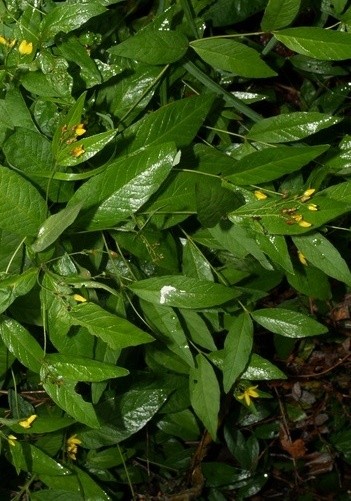Garden Loosestrife
(Lysimachia terrestris)

Description
Lysimachia terrestris, commonly known as Creeping Jenny or Moneywort, is a fascinating and enchanting plant species that belongs to the family Primulaceae. With its vibrant yellow flowers and creeping growth habit, Lysimachia terrestris has become a popular choice among gardeners and plant enthusiasts. In this article, we will explore the various aspects of this remarkable plant, including its taxonomy, morphology, habitat, cultivation, and uses. Taxonomy Lysimachia terrestris falls under the Kingdom Plantae, Division Magnoliophyta, Class Magnoliopsida, Order Ericales, Family Primulaceae, and Genus Lysimachia. The species name "terrestris" is derived from Latin, meaning "of the earth," which aptly describes its low-growing and creeping nature. Morphology Creeping Jenny is a herbaceous perennial plant that typically reaches a height of 10 to 30 centimeters (4 to 12 inches). It features long, trailing stems that sprawl along the ground and root at the nodes, aiding its creeping habit. The leaves of Lysimachia terrestris are opposite, oval-shaped, and glossy, measuring around 2 to 3 centimeters (0.8 to 1.2 inches) in length. The vibrant yellow flowers, borne on slender stalks, bloom in clusters and are approximately 1 to 2 centimeters (0.4 to 0.8 inches) in diameter. Habitat and Distribution Lysimachia terrestris is native to Europe, specifically found in regions such as the British Isles, Scandinavia, and central and southern Europe. It thrives in moist and shady environments, commonly found in damp woodlands, along stream banks, and in wet meadows. However, it also exhibits adaptability and can tolerate a range of growing conditions, including full sun to partial shade. Cultivation Creeping Jenny is known for its ease of cultivation, making it a popular choice for both beginner and experienced gardeners. Here are some key factors to consider when growing Lysimachia terrestris: Soil: This plant prefers moist, well-draining soil rich in organic matter. It can tolerate a wide range of soil pH levels, from slightly acidic to slightly alkaline. Sunlight: While Lysimachia terrestris can grow in full sun, it thrives best in partial shade or dappled sunlight, especially in warmer climates. Watering: As a moisture-loving plant, Creeping Jenny requires consistent watering to keep the soil evenly moist. Avoid overwatering, as it may lead to root rot. Propagation: Propagation of Lysimachia terrestris can be done through various methods, including division, stem cuttings, or by sowing seeds in a well-prepared seedbed. The division method is most commonly used, with the plant being divided in spring or autumn. Uses Ornamental Plant: Creeping Jenny is primarily cultivated for its ornamental value. Its low-growing habit and bright yellow flowers make it an excellent choice for ground cover in gardens, borders, or as an accent plant in containers. Erosion Control: Due to its creeping growth habit and ability to form dense mats, Lysimachia terrestris is often employed to control soil erosion on slopes and embankments. Water Gardens: The lush, trailing nature of Creeping Jenny also makes it a popular choice for water gardens. Its ability to tolerate moist conditions and its attractive foliage add a touch of beauty to ponds, water features, and the edges of water bodies. Medicinal Purposes: In traditional herbal medicine, Lysimachia terrestris has been used for various medicinal purposes. The plant is believed to possess diuretic properties and has been used to treat urinary tract infections, kidney stones, and other urinary disorders. However, it is important to note that the efficacy and safety of these traditional uses have not been extensively studied and should be approached with caution. Wildlife Habitat: Creeping Jenny provides valuable habitat and food sources for various wildlife species. Its dense mats and nectar-rich flowers attract pollinators such as bees and butterflies, contributing to biodiversity in the surrounding ecosystem. Economic Value: In some regions, Lysimachia terrestris has been commercially harvested for its use in floral arrangements and wreaths. Its trailing stems and bright yellow flowers add a vibrant touch to floral compositions and can be used in both fresh and dried arrangements. Potential Concerns While Lysimachia terrestris is generally a low-maintenance and beneficial plant, there are a few considerations to keep in mind: Invasive Potential: In some areas, Creeping Jenny has exhibited invasive tendencies, particularly in moist, shaded habitats. It can spread rapidly and outcompete native vegetation, potentially disrupting local ecosystems. It is crucial to check for any regional restrictions or invasive species listings before introducing Lysimachia terrestris into natural or protected areas. Toxicity: Lysimachia terrestris is not known to be highly toxic, but like many plants, it may cause mild gastrointestinal upset if ingested. It is advisable to keep it out of the reach of children and pets. Conclusion Lysimachia terrestris, or Creeping Jenny, is a captivating plant species with its vibrant yellow flowers, trailing growth habit, and adaptability to various growing conditions. It serves as an ornamental plant, erosion controller, and habitat provider for wildlife, and has been used in traditional medicine and floral arrangements. However, due to its potential invasiveness in certain areas, caution must be exercised when introducing it into natural environments. Overall, Lysimachia terrestris continues to enchant gardeners and nature enthusiasts alike with its beauty and versatility, adding a touch of sunshine to any landscape it graces.
Taxonomic tree:







